Opinion & Analysis
Is Park Golf the world’s next golf craze?

Before the onset of Covid-19, the number of new golfers taking up the game was on a decline worldwide. The same trend was prevalent here in South Korea until the pandemic unexpectedly created a golf boom over the past 3 years. And thanks to state-of-the-art golf simulators and its easy accessibility, the ‘screen golf’ culture here made it safe and easy for newbies to get a taste for the game.
Now as the threat of the virus abates, a recent study showed that many of the new golfers are leaving the game in search of other activities. If you are familiar with Korea’s golf environment, the reasons are understandable. Although we are the world’s third largest consumer of golf, the high costs to play the game keep the entry barrier high. Playing a round of golf is much more affordable and easier in the US and Canada to be sure, but today I would like to talk about a new form of golf that has enjoyed tremendous growth and popularity here in recent years.

A new strain of golf virus that is sweeping Asia and coming to America is… Park Golf! (Picture: www.gigagolf.co.kr)
Park Golf… Say What Now?
Park Golf is a new type of golf that started in 1983 in a small town in Japan. The founders of Park Golf wanted to play a game of golf that was easily accessible and playable for people of all ages while keeping the name, rules, and equipment as simple as possible.
As the name implies, Park Golf literally means playing golf in a park. Using pretty much the same rules as regular golf, the goal is to get the ball into a hole using the fewest strokes. The game is played on a small 9- or 18-hole course about 1/10th the size of an actual golf course, and even uses the same words like par, birdie, eagle, out of bounds, etc.
The key difference is that Park Golf only requires a single club that resembles a croquet mallet with zero-degree loft and a plastic ball the size of a billiard ball. Imagine a faster-paced game of croquet with the rules of golf and voila. Park Golf, or as I first called it, Geriatric Golf.
Right. So why would any self-respecting golfer find this miniaturized version interesting at all? When it first came across my desk a couple years ago, my snort of derision was heard across the office upon reading that it was comparable to REAL golf for fun and enjoyment.
Give me a break. But then it kept popping up again and again throughout the year; how fast it was growing, how so many cities and provinces throughout Korea are allotting funds and land to encourage the ‘sport’, and so on. The tipping point where I finally decided to see what the hubbub was about was when I noticed that a Park Golf course was operating within walking distance from my office.

Park Golf has it all, complete with bunkers, rough and fairways, and even OBs.
Overall, it took me over a year to actually work up enough curiosity to stand on the first tee box with a mallet club in my hand. However, I was soon surprised to find myself obsessing about how to hit the ball straighter and further – all things that I would normally do at Golf. Of all the similarities it has with Golf, the addictive nature had to be the biggest.
Park Golf, Past And Present
Unbeknownst to most, Park Golf has been around for a while and this year actually marks the 40th anniversary of the sport. Since it was first conceived in 1983 in the small non-descript town of Makubetsu, Japan, it is now actively enjoyed in over 18 countries including the United States, Canada, China, Australia, Taiwan, and Central America.
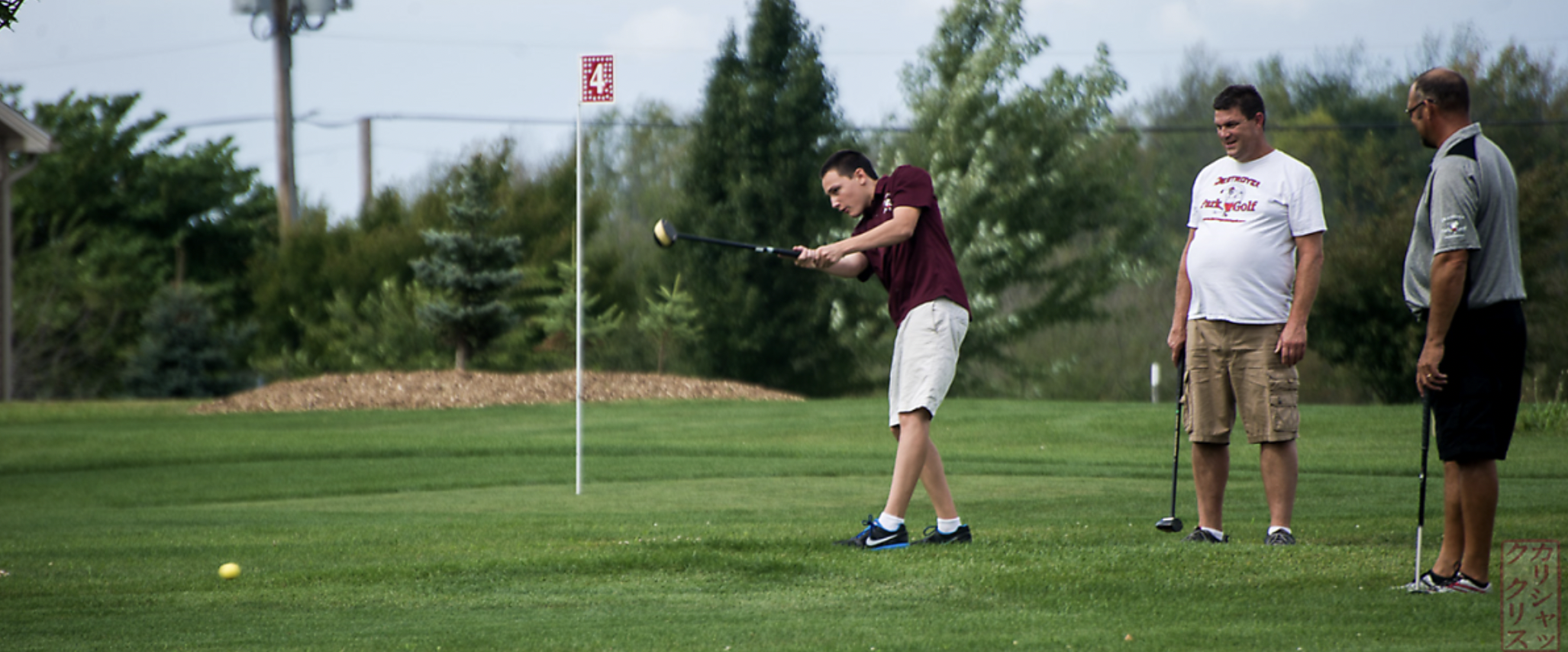
For some addictive golf action at a fraction of the price, Park Golf can’t be beat (Picture: DestroyerGolfPark.com)
In Japan alone, there are now more than 5 million players (or “parkers” as they call themselves) and over 700 Park Golf courses playing under the official rules set out by IPGA (International Park Golf Association). In Korea, Park Golf has also grown rapidly since its introduction in 1995, and owing to the incredibly addictive nature of the sport (it is golf, after all), the number of courses and players has nearly doubled year on year to rival those of Japan.
In addition, the number of new Parkers is growing by hundreds each day, so much so that even large OEM manufacturers like Callaway, Mizuno, and Honma have jumped in to make equipment for the sport. What began as a humble game in a small Japanese town, Park Golf is now supported globally with an official Park Golf Association in many countries, all following a systematic framework of game rules, equipment, and hosting of various domestic and international competitions around the world.
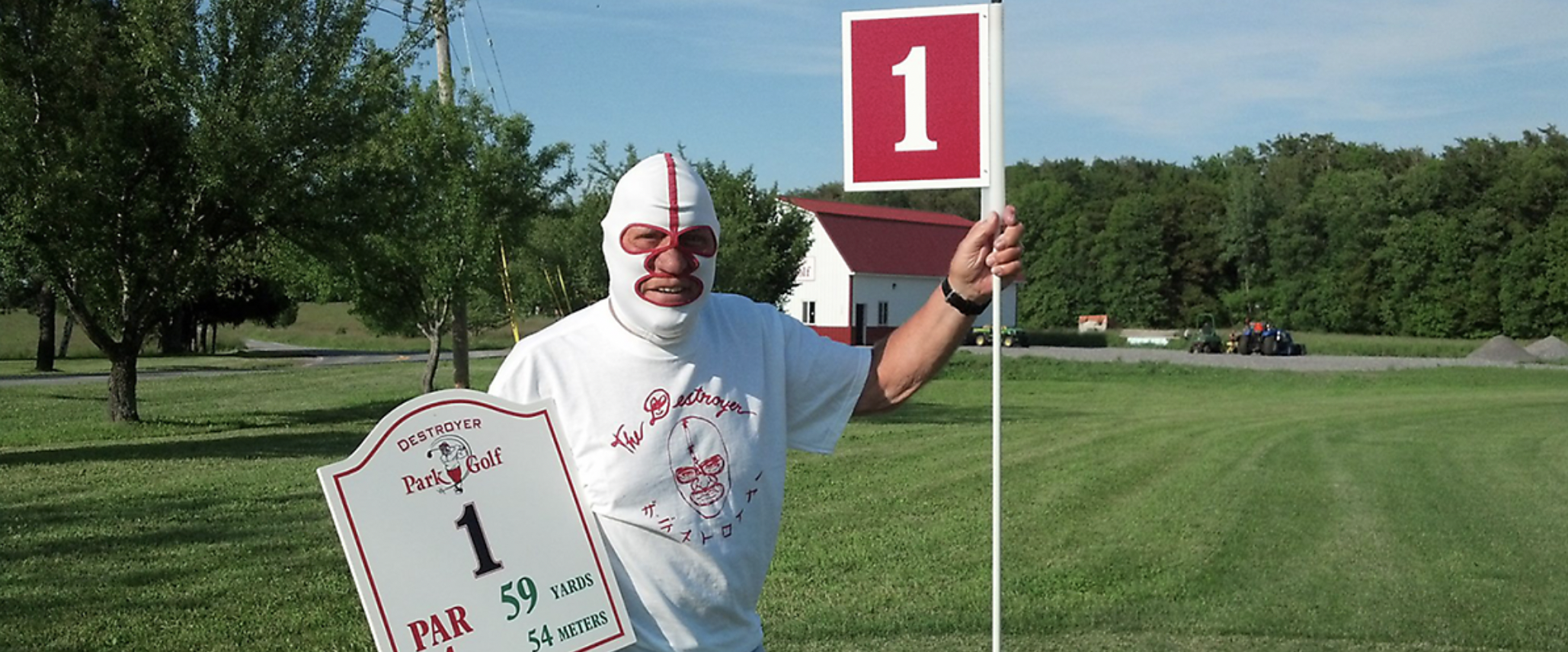
Dick Beyer in his trademark mask at Destoyer Park Golf, America’s first PG course (www.destroyerparkgolf.com)
It may also surprise you to know that Park Golf is also alive and well in America, just 40 minutes outside Buffalo in the town of Akron, New York. A quick search on Google found that the game was introduced to the US in a big way by Hall of Fame professional wrestler Dick “The Destroyer” Beyer.
During his career in Japan, he fell in love with the game and began dreaming of introducing the sport to the US. As a result, America’s first DESTROYER PARK GOLF was launched in 2013. The par-66, 18-hole course is proudly owned and maintained by the married couple, Kris Beyer and Chris Jones, who are both die-hard advocates for the game. Details of their story can be read here.
Park Golf Rules & Equipment
Park Golf rules for the golf course and equipment are created and strictly governed by IPGA, formerly named Japan Park Golf Association (https://ipgaa.com/ in the US). Similar to golf, it is played on a Park Golf course with 18 holes that make up a golf round. Each hole is 20 to 100 meters long and the hole width is 8 inches in diameter and fitted with a flag pin. The par 66 course is approximately 1/10th the size of an actual course and is made up of par 3, par 4, and par 5 holes. A typical round can take up to about 90~120 minutes, depending on the pace of play and skill level.

Birthplace of Park Golf, the town of Makubetsu in Japan (Picture courtesy of Park Golf NPGA on YouTube)
True to the founders’ original philosophy of keeping the game simple, you only need one club, a ball, and a rubber tee. The mallet-shaped club can be made of wood, carbon, and steel, and uses a thicker carbon shaft than a regular golf club. It too is regulated by rules that it must be no more than 86cm in length and no more than 600g in total weight.
The club face is reinforced with a carbon face to absorb the impact of a plastic ball weighing around 90 grams, and has zero loft (it takes some skills to get the ball airborne past the knee!). As a side, I was worried that hitting a bigger heavier plastic ball might cause injury, but the mallet club and its shaft absorbed any shock that the impact produced. It felt ‘pure’ when hitting out of the middle of the club face, and the exhilaration from a shot struck well was just like those in regular golf.
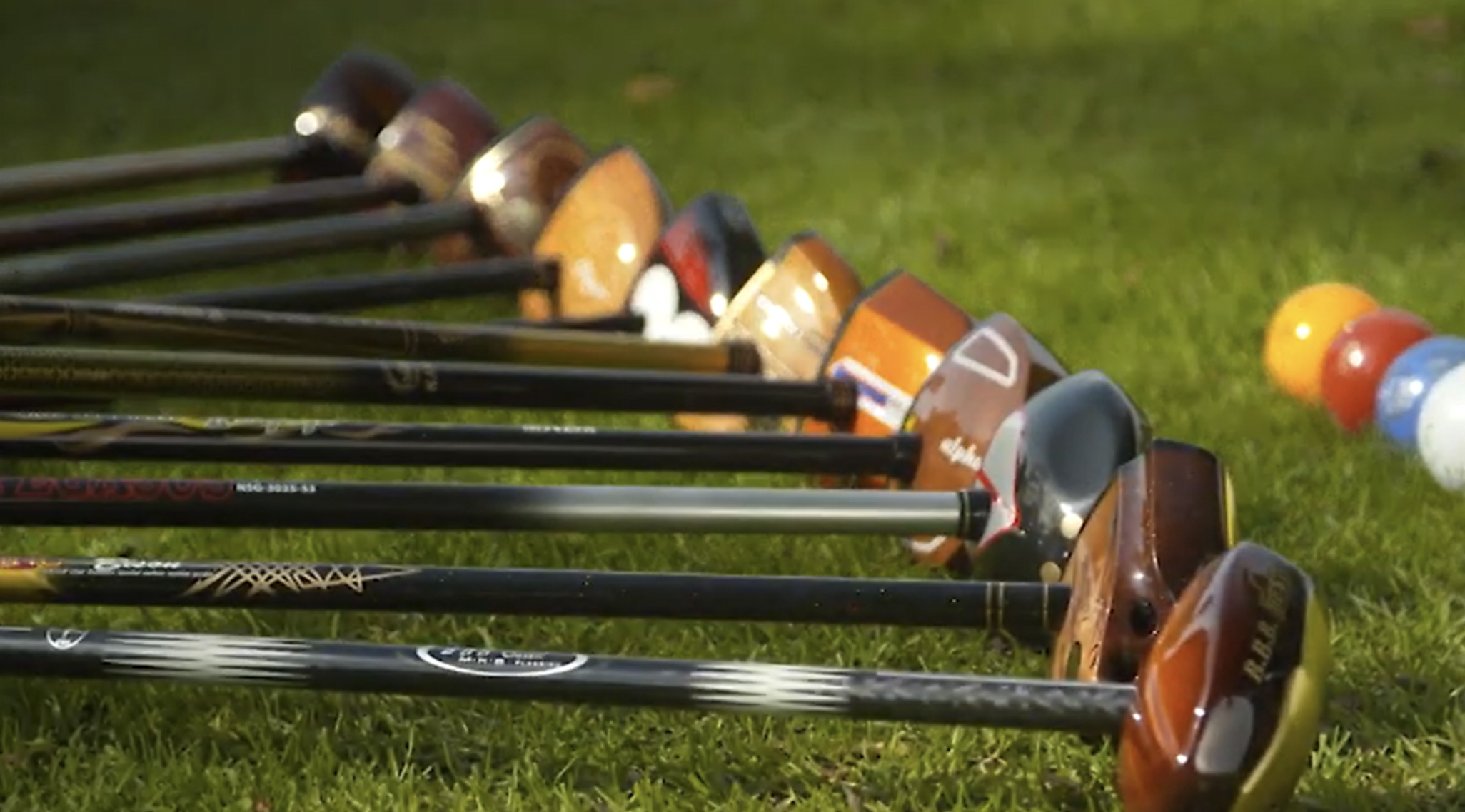
Park Golf equipment is simple. Just add skills. (Picture: www.parkgolf.or.jp)
The tee box is typically a golf mat 1.25m x 1.25m in size. Balls are made of special plastic materials and are teed up on rubber tees for stroke play or match play. Like regular golf, it can be played with up to 4 players, but can also be played alone. Similar rules and etiquettes from golf are followed and there are marked areas for out-of-bounds where penalty strokes are imposed.
Park Golf may seem that it is easier to play, as it requires less number of clubs and shorter holes. Dubbed as being “croquet on steroids” however, the game is quite formidable and is not be compared to mere pitch and putt. One challenging aspect is that the ball usually rolls along the ground for most of the hole, and gauging the right amount of oomph to send the ball to desired distance requires both experience and muscle control. For me, it was maddeningly engaging as I expected to dominate the sport on my first outing. To the guffaws of the seniors I joined to play my first round, I failed to break 90 despite playing golf for 35 years. It was on.
Benefits of Park Golf
The great advantage of Park Golf is its inclusivity and accessibility. The whole family can enjoy it together at a fraction of the cost it takes to play Golf. For example, the price of a round of Park Golf near me is between 2,000 and 5,000 Korean Won, and less than $10 a round in the US.
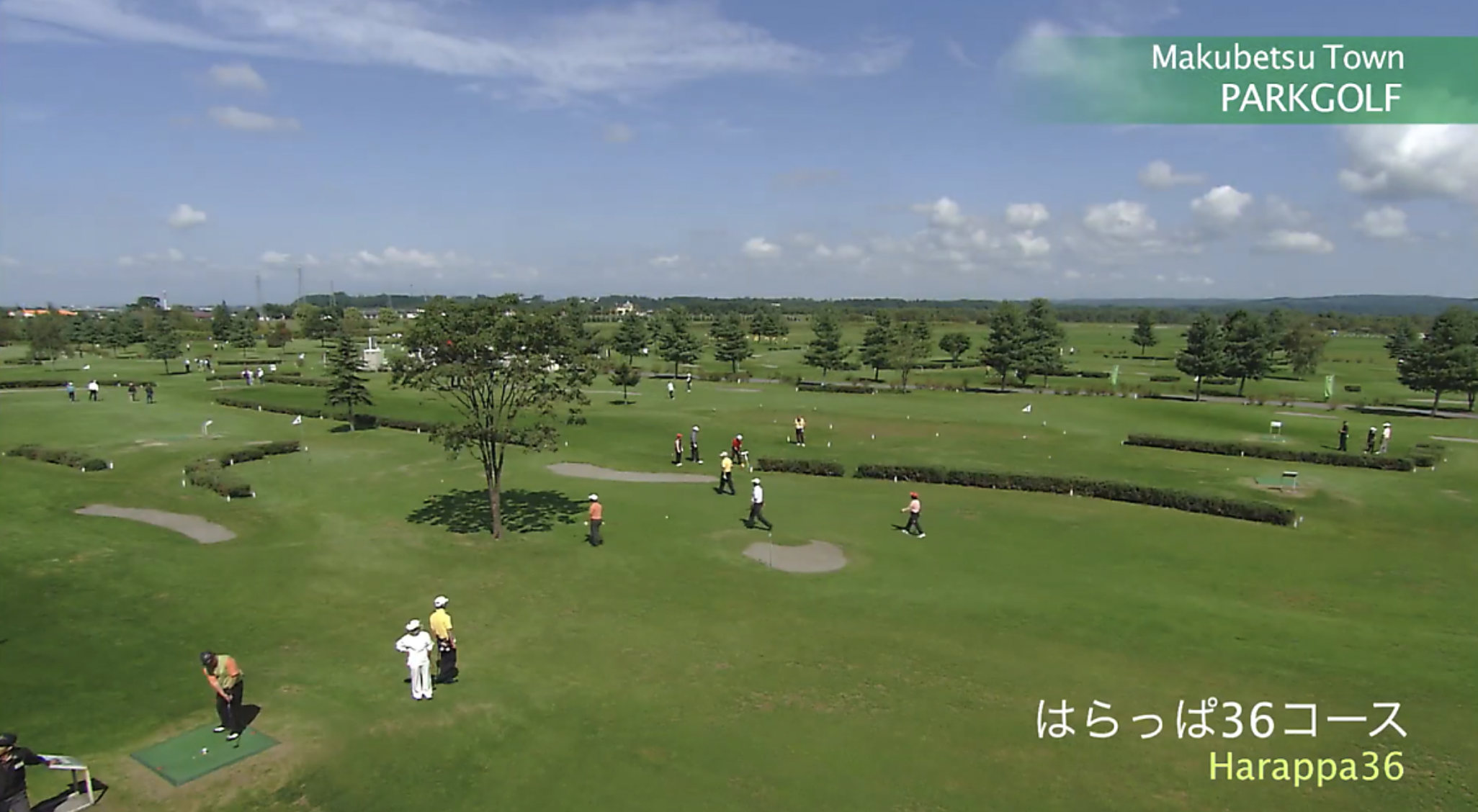
The town of Makubetsu in Japan is like the St.Andrews of Park Golf (Picture courtesy of Park Golf NPGA on YouTube)
You can probably guess why Park Golf is so popular in Asia given the steep green fees and the long hours it takes to play a round on a regular course. With Park Golf, the entry barriers are low and it offers plenty of fresh air and exercise compared to indoor golf simulators. The break-out industry is also helping local communities in many ways, and have shown to benefit the social well-being and welfare of senior citizens by fostering healthier lifestyles, new connections, and friendships.
Furthermore, Park Golf is growing at a tremendous speed both here and overseas because it can be enjoyed by men and women, boys and girls of all ages. Puh-lease, right? You’ll never catch me playing this glorified putt-putt. I’ll give up regular golf on my deathbed, you say? Yep. I said it too. But in this age of sitting and staring at mobile phone screens all day, Park Golf may just be the perfect leisure activity for the whole family to enjoy well into ripe old age.

A family affair. (Picture courtesy of Park Golf NPGA on YouTube)
My mom and dad recently visiting from Canada had a blast playing with me. As golfers themselves, they were making jokes about Park Golf too. But they were soon into how similar it felt to actual golf. After the quick round, my dad wondered aloud if they’d be around to play a round with me and my own son, who just turned one. A small lump caught in my throat, and I said a small prayer inside wishing that three generations of our family can one day stand on the tee box together.
So What Is It Really Like?
My first round of Park Golf was late last May as a walk-on with a friend. This fact in itself is amazing, since NO regular golf courses in Korea allow walk-ons or joins. The mini-course was quite busy with mostly older seniors but a few middle-aged folks were playing with their children. I watched with interest as an older gent hit his tee shot toward the green with a wooden mallet and thought this would be a walk in the park, pun intended.

A short 5-min walk from my office at $7 a round. Best lunch hour, ever. More than 3 hundred of these in Korea so far and growing.
I was in for a rude awakening as I carded back-to-back triple bogey on the first two holes. Luckily my friend didn’t fare any better, so we decided to put a small wager on our Ryder Park match and the rest was history. For the next month, we spent our lunch hours power-walking to the course next to the office and screaming at the ball to either get there or sit down. The older parkers looked at us scrambling around their turf in amusement, but we were too immersed to notice most of the time. After all, those narrow holes flanked by OBs were no joke.

OB stakes suck regardless of whether its Park Golf or regular golf. (Picture: www.parkgolf.or.jp)
By the end of the summer, my best score was +2 over par and I even managed to card a hole-in-one; something I never did on a larger golf course. It was a great ego boost, and I was strutting around like a peacock until I overheard a septuagenarian behind us saying he shot 12 under par that morning. It’s good to have goals.
I think the fun and benefits of Park Golf is often underestimated due to its simplicity at first, especially by golfers. Again, it takes legit skills to make a larger 80~100g ball fly a hundred meters with a zero-lofted club. Like regular golf, distance control is very important and can take a while to be able to control the roll for distance over uneven terrain. And don’t even get me started on the topic of backspin. Imagine using only a putter to play a 300-yard hole and you get the idea.
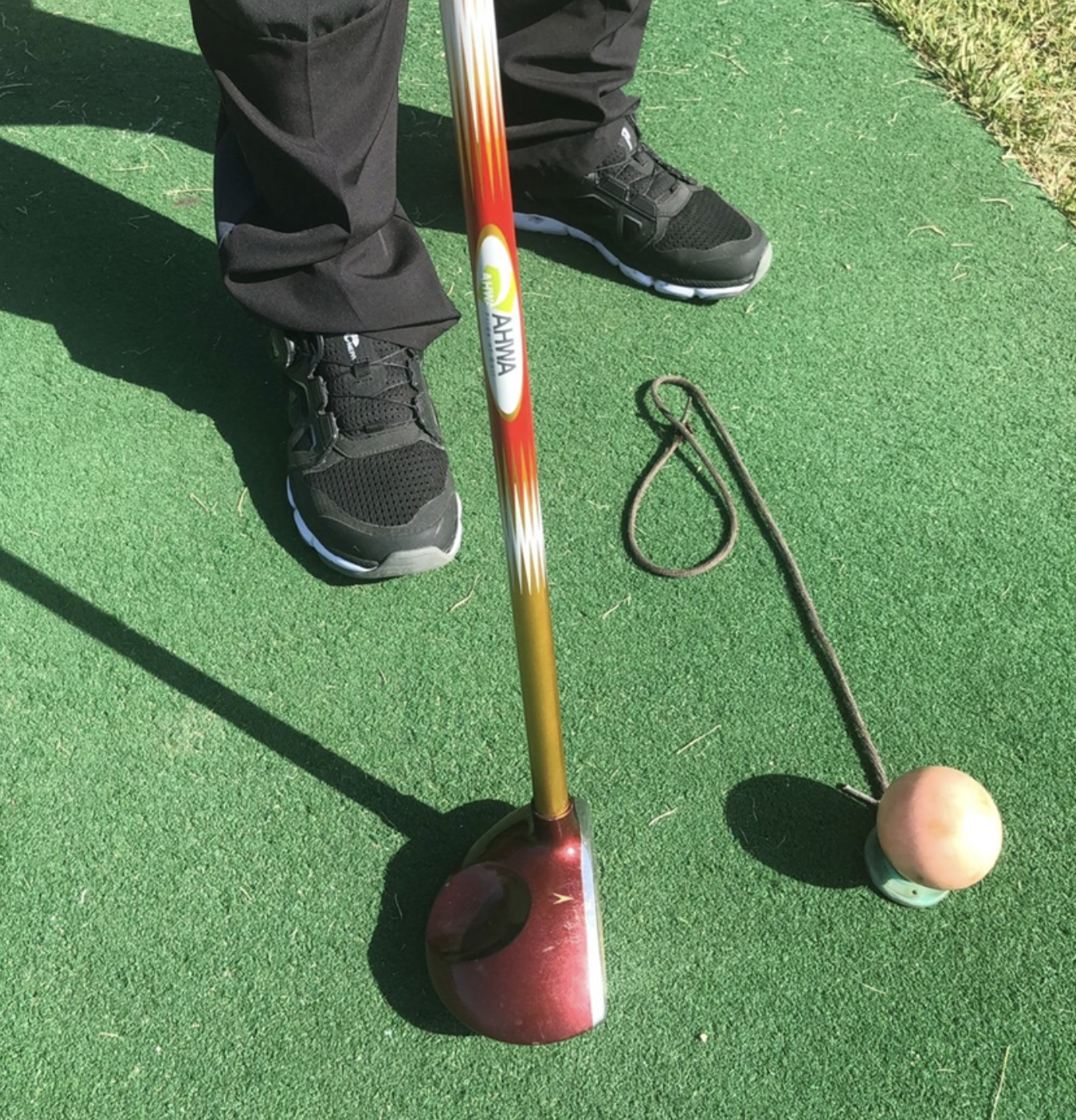
Once you tee up the ball, it can’t be touched until you hole out.
My experience with Park Golf was every bit as competitive and stimulating as a normal round of golf. With the low cost and easy accessibility here in Korea, I can only foresee the sport getting bigger and bigger. In addition to the aforementioned OEMS, many Korean golf club manufacturers have also turned their attention to creating Park Golf clubs which can run you up between $300~$1000 for a single club. Luckily, local courses also rent clubs and balls for about $2 to further lend themselves to easy access and enjoyment.
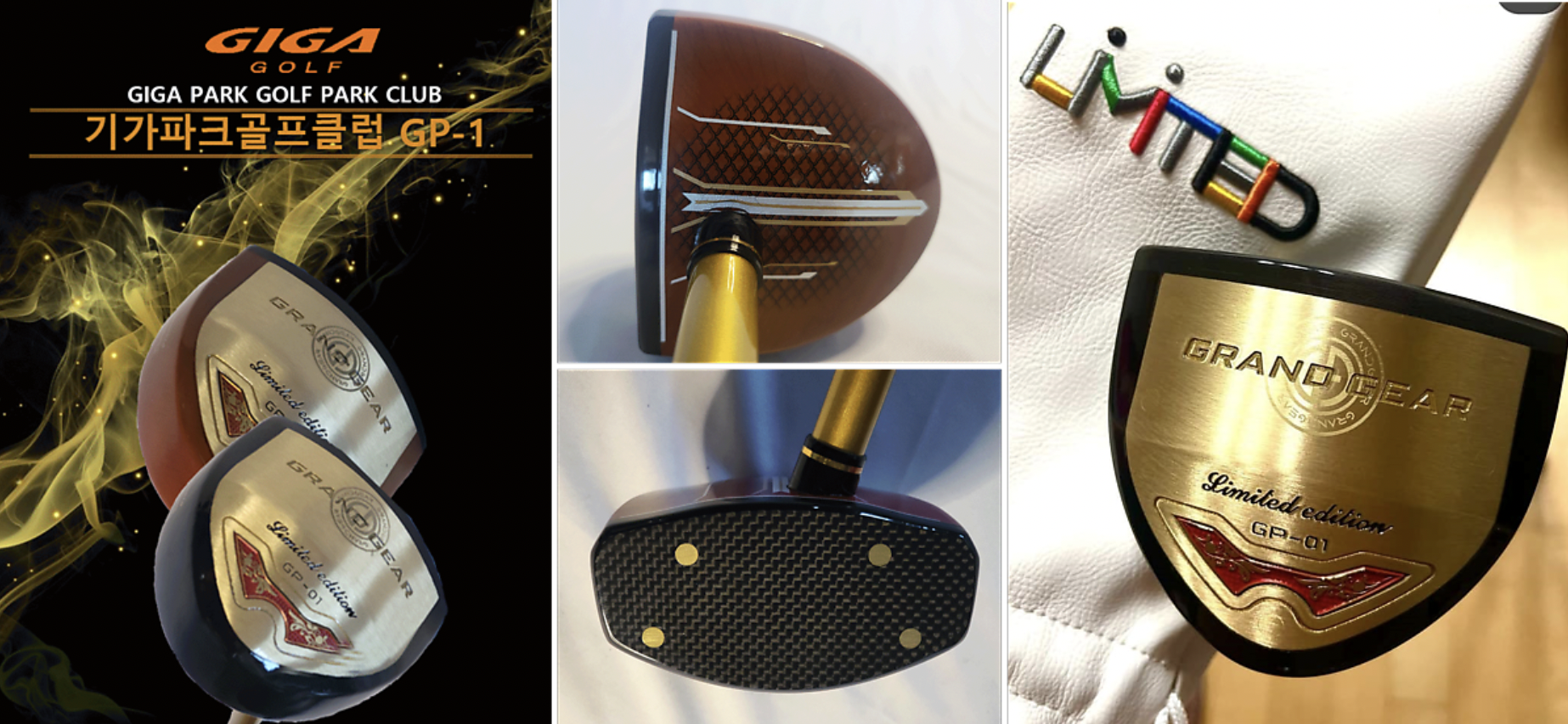
A renowned Korean golf club manufacturer Giga Golf has said it has seen huge demand growth for Park Golf equipment (Picture: www.gigagolf.co.kr)
Interestingly, I have recently learned that fierce competition exists between Japanese and domestic manufacturers in the equipment sector for Park Golf, so you just know that this sport will break out globally soon. For those who are in urban planning or social welfare sector of local and municipal government, this could be the next big local attraction to elevate your city’s status. I know I’d love to see Park Courses when I visit Vancouver.
In all fairness, the first instinctive response of most golfers reading this will be dismissive. Sure, I get that. We already play the greatest game on earth, so why settle for a discounted version? I did the same. My advice, though? Don’t knock it till you’ve tried it. There are now over 15 million parkers and more converts like me coming every day.
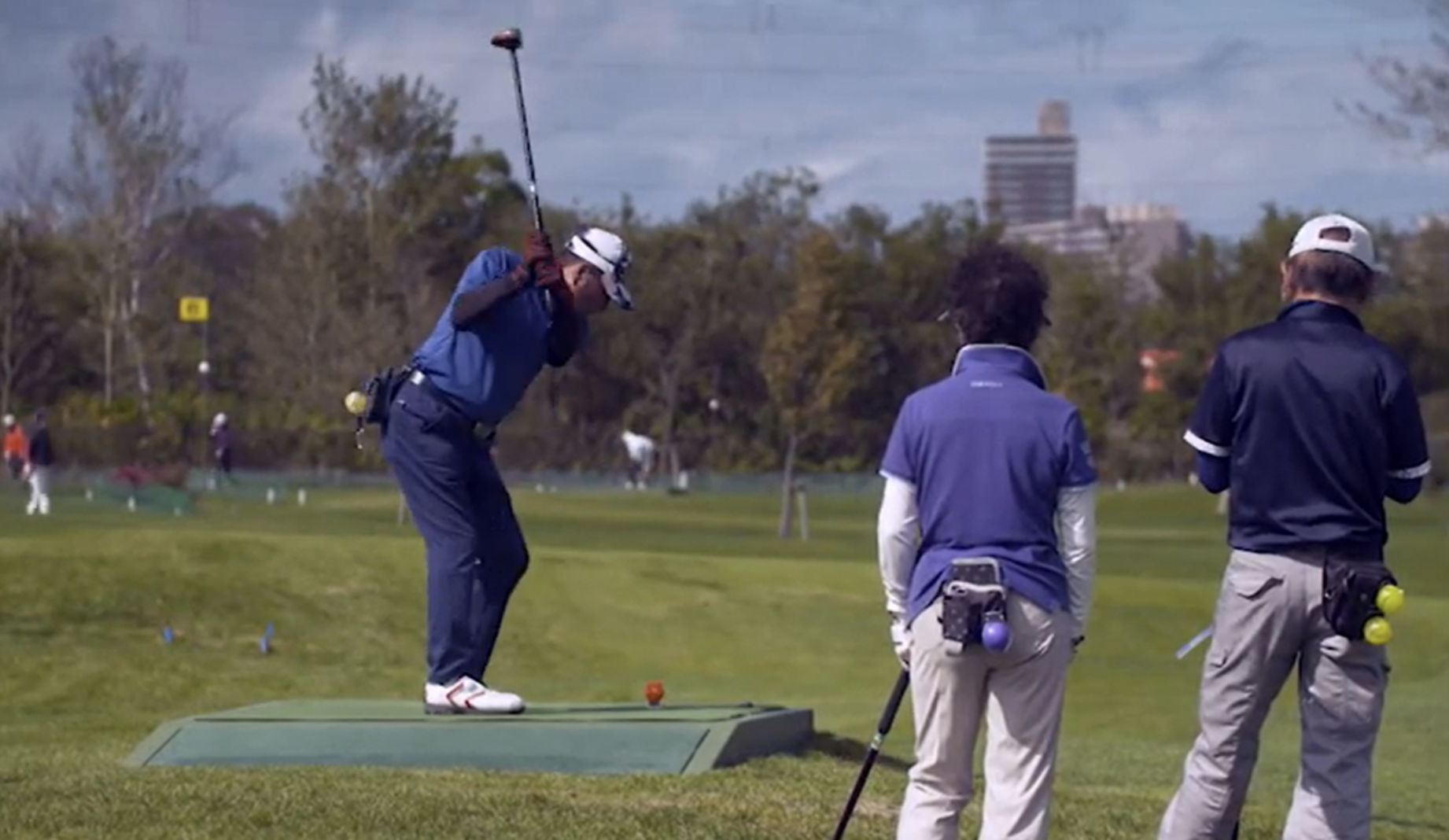
Check out the power swing and the accessories on the waist clip. Niiiiiice. Gotta look good no matter what sport we play. ((Picture: www.parkgolf.or.jp)
I started golf towards the end of Jr. High and missed out during grade school because I thought it was for old fogies. In high school, friends who didn’t play golf said the same thing and laughed at my Argyle pants. I often wonder how their addiction to golf is going now. I bet they wished they started sooner.
The moral of my story is we’re not getting any younger. So if you get a chance to swing a mallet, go ahead. Live life, I dare you. You’ll be glad you did.
- LIKE108
- LEGIT7
- WOW6
- LOL7
- IDHT1
- FLOP1
- OB2
- SHANK21
Opinion & Analysis
The Wedge Guy: What is a “wedge” anyway?
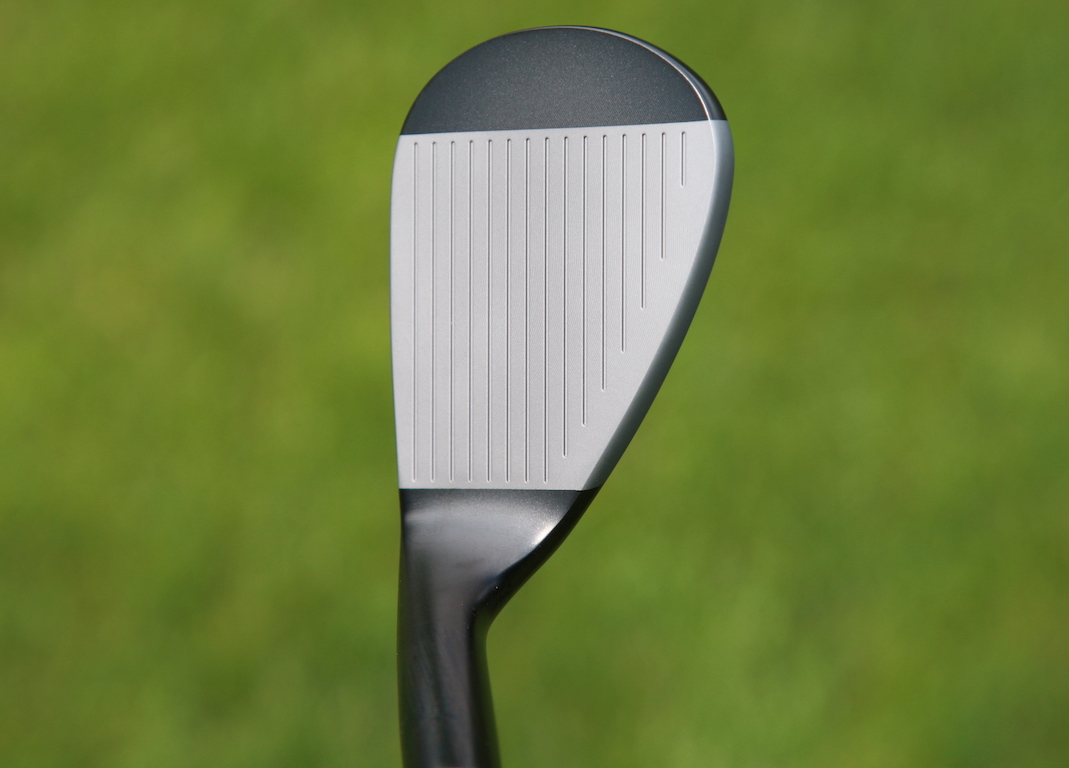
This week’s post is somewhat of a continuation of the recent path we’ve been on, discussing the nuances of those high-loft clubs at the short end of our sets – those specialty clubs we call “wedges.” The real question might be:
“What is a ‘wedge’ anyway?”
Can that name be given to any iron-type club simply based on its loft? And if that’s the defining criteria, where do “wedge” lofts begin? And can clubs of all different design configurations still all be “wedges” just because they fall into that arbitrary range of lofts?
To the first question, my historical research indicates the term “wedge” first came into common use in the 1930s with the invention of the original sand wedge, generally credited to Gene Sarazen. As the legend goes, after flying with Howard Hughes and observing the use of flaps to make the airplane go up or down, he conceived the idea of a downward angle on the sole of a niblick to make it “reject” from the sand. So, after numerous prototypes and testing, the club that came to be known as the “sand wedge” was born.
Those clubs were about 55-56 degrees of loft, and quickly became widely adopted because of this revolutionary performance from bunkers. My guess is the term “wedge” was applied to that club because that’s exactly how you used it – you “wedged” the club between the ball and the turf – loft made the ball go up and the sole made the club “bounce” off the turf.
The professionals of the 1940s and 1950s began to use their sand wedge for more specialty shots around the greens, but most often relied on their highest lofted iron for most routine pitch shots. In sets back then, that club had 50-52 degrees of loft and was often called a “pitching wedge,” but some labeled it simply a “10-iron,” or in Ben Hogan’s case, the Equalizer.
But that club looked like the irons it matched, bearing little resemblance to the specialty “sand wedge” with its big flange and heavy sole, but I really don’t know why it was also called a “wedge.”
As iron lofts began to strengthen in the 1980s, the need for a “gap wedge” came about, as that valuable 50- to 52-degree iron was disappearing. Then at the other end of the set, the “lob wedge” appeared. Both of those clubs bore some resemblance to the sand wedge because they were most often presented as loft extensions in manufacturers’ wedge product lines.
So, now let’s fast-forward to 2023. Most iron sets have a “P-club” of rarely more than 45 degrees, and we’re seeing more and more with as low as 42 degrees of loft. Many of the iron models offer set-matching “wedges” labeled “A”, “G”, “S”, etc. to extend the iron design up into the higher lofts. These all look almost identical to the 6-iron in that set, because this industry is still caught up in the notion of “matched” sets. (But that’s a topic for another day)
In the “wedge” category, product lines can be confusingly broad, with lofts from 46 to 64 degrees and all kinds of specialized sole configurations. So, back to the original question — what is a “wedge?”
Think about it this way.
At the long end of your set, the club with 22 to 24 degrees of loft might be configured as a fairway wood, or a hybrid, or a hollow high-tech “driving iron,” or simply the 4- or 5-iron that matches your irons. Each golfer can determine which configuration serves him or her best at that loft and the distance it produces.
Likewise, the clubs at the higher loft end of your set might look like your 6-iron, or might look like a traditional wedge, or might look like one of the numerous specialty wedges with a wider sole. My “wedge” designs for Edison Golf don’t really look like any of those.
But just like those options you have to build out the long end of your set, each of those various ways to configure a higher-lofted club will produce different results. So, can we really lump all of these high-loft options into a singular category and call all of them “wedges?”
Or is it time to come up with a totally different word to describe those high-loft clubs in our bags that have the assigned task of delivering consistent results at a range of distances as we get closer to the green?
I’m not sure I have the answer, but it should be fun for all of us to stop and ponder the question? Your thoughts, everyone?
- LIKE17
- LEGIT6
- WOW0
- LOL0
- IDHT0
- FLOP0
- OB0
- SHANK4
Opinion & Analysis
The best bets for the 2023 John Deere Classic

Probably not quite the ‘classic’ of its name, but the John Deere provides some recall of the good and bad of golf betting.
Back in 2013, a young Jordan Spieth made his reputation by sinking a 72nd hole bunker shot to put the willies up course specialist and lumpy bet Zach Johnson. As is the way, the Deere Run guru then bogied his final hole, going on to defeat in a three man play-off.
Fast-forward nine years and J.T Poston landed a confident wager in last year’s event, leading all the way to land a comfortable three shot victory. Can’t wait to see which way it goes this time.
Expect birdies galore around the course this week, with very little difficulty in finding fairways.
With most of the field managing to hit the large greens, GIR stats are less worthy than they might otherwise be. Instead, players need to hit it close enough so they make the majority of putts. As with previous winners Bryson DeChambeau and Lucas Glover (to name just two), high-class ball-strikers can give themselves enough chances to land their share of birdies.
Current form looks a must here this week, with cross-over form from Travelers including Spieth, DeChambeau, Daniel Berger and Brian Harman, and Rocket Mortgage champions Cameron Davis and DeChambeau showing up well at this week’s venue, all recording a similar winning score.
When the market opened, I felt Emiliano Grillo would be third or fourth favourite, so finding him at a bigger price than PGA maidens Denny McCarthy, Adam Schenk and new star on the block Ludvig Aberg was a pleasant surprise.
The three names seem to have more improvement in them than the 30-year-old Argentine, but none have the victories, or the course form, to justify being ahead in the market.
McCarthy has lifted his reputation even further with his play-off loss at Muirfield and leading to halfway at River Highlands, but he faded away when under the cosh here last year, allowing the experienced Grillo to be the closest challenger to Poston (alongside Chritiaan Bezhuidenhout), whilst the 23-year-old Aberg may well be the Second Coming but faded away late on at both River Highlands and Detroit, recording large minus figures for his iron play. Sub 25-1? Really.
Schenk makes a lot of sense on recent form, with iron play making up the most of his impressive tee-to-green stats, but at anything over 25/1 in a weak field, the Charles Schwab winner appeals more than anyone.
Grillo ranks 3rd on tour-tips overall ranking for this event, with half-a-dozen instances of top-25 tee-to-green play in his last eight starts. In the same period (since Bay Hill) the Argentine has listed in the top 12 for approach play on five occasions, leading the field at the Arnold Palmer and ranking 12th at Travelers.
The 15th place at River Highlands on his last outing is the best finish there since 2018 (19th) after which Grillo suffered a slump, falling down the world rankings from 47th to 156th during 2020.
2021 saw him come back with a runner-up behind Stewart Cink at Harbour Town, following up a year later when matching his second place here with a silver medal behind a rampant Tony Finau at the 3M.
Grillo was trending in the right direction before his play-off win at Colonial, with form figures of 7/5/23 and an unconcerning missed-cut at the PGA, and the win, from a nervous Schenk, and the world number one Scottie Scheffler, reads very nicely in this field.
Whilst never the greatest putter in the world, that aspect has improved greatly. Now ranking in 6th for putting average off a large number of greens hit, he has positive figures at five of his last seven starts and comes here recalling last season’s +8.5 strokes tee-to-green and +4 strokes for the flat stick.
Doug Ghim is playing nice golf at the moment, several years after being touted as a superstar.
This test suits the short-hitting but accurate player, and with form figures of 33/15/12/19/27, he’s the type to appeal as a solid top-20 bet.
For win purposes though, I’ll revisit a Grillo formline and row in with the man that lost to the selection by just one shot at the Web.com Tour Championship some eight years ago, Chez Reavie.
I put up the 41-year-old a couple of weeks ago at a monster 200/1 to regain his 2019 Travelers crown, and he gave us a thrill until fading away on Sunday, yet still paying out a healthy return for a place.
A 2021 finish of 18th and a previous pair of top-15 finishes led to him going off around 50/1 for this event 12 months ago, and I’m not sure he’s done anything, or faces tough enough opposition, to be 10 points longer.
Previous to his latest win at the Barracuda in July last year, the three-time winner posted 27th at Colonial and 8th at River Highlands. This time, he comes here after being 12thg at the halfway stage of the Charles Schwab and in second place after three rounds in Connecticut.
Now, with six consecutive cuts made and four of his last eight rounds in the low-to-mid-60s, he arrives after recording an average of between 5.5 and 6.0 strokes for approaches and tee-to-green, a repeat of which will see him bang there come Sunday evening.
With River Highlands and Deere Run form in abundance, he’s yet another old campaigner I feel will prove too much for the young guns.
Finally, we’ll go with a pair of three-figure pokes, firstly in the way of David Lipsky, a player with two wins on the European Tour at tracks that require a touch of guile over strength.
It may be five years since the 34-year-old worked his way around Leopard Creek to back up his Crans victory, but his career has not been devoid of highlights, including a four shot victory over Taylor Pendrith at the short San Antonio course in Texas.
2021 saw him record six top-10 finishes, including at Abu Dhabi and Valderrama, whilst a year later he finished top-10 at the Corales and better-class Mexico Open behine Jon Rahm and Tony Finau.
A season-opening top-five at the Sony promised much and, whilst it hasn’t gone that well, Lipsky can still boast top-20 finishes at the Charles Schwab and Memorial, where at halfway he was first and sixth respectively.
Always around 24th place last season, Lipsky has shown he can raise his game at a lower level, whilst two of his three victories have come in 25-under and 18-under. He can do a job when conditions suit, and at 125/1, he’ll do as a chance to gain some decent each-way money.
Next to him at 125s is 26-year-old rookie Carl Yuan, now finding his feet at this level yet massive amounts of points bigger than some of his more sexy rivals.
A winner on his home tour, he had a remarkable 2022, winning in Louisiana, and racking up a further four top-five and four top-10 finishes and getting himself in at the highest level a year after he was due.
Explaining why he missed promotion 12 months earlier, Yuan said it was every player’s dream to represent their country, so popped off to The Olympics rather than guarantee his PGA card through the final six events of 2021.
Still, he’s here now and, after a slow start, made three consecutive cuts – Houston, RSM and Sony – before another lull from mid-January.
Shaking that off, he bounced back to form with the halfway lead at the better-class Canadian Open, stating, “That’s my goal [retaining his card] coming into the week. That’s my No. 1 goal. Not a result goal, just like being in the present, hitting shot by shot and, yeah, being out here trying to have the most fun. All of it.”
It seems to be working as he finished a highly respectable 18th before landing another top-20 at Detroit last week after a third-round 64 had gotten him inside the top-10 going into payday.
This massive hitter will be able to club down for most of this week’s test, ensuring he builds on some steady seasonal figures for tee-to-green and with untold improvement to come.
There is a chance he needs a much bigger environment to thrive, but as an unexposed, potentially high-class improving recruit, he needs taking a chance with.
Recommended Bets:
- Emiliano Grillo
- Chez Reavie
- David Lipsky
- Carl Yuan
- LIKE1
- LEGIT0
- WOW1
- LOL0
- IDHT0
- FLOP0
- OB0
- SHANK0
Opinion & Analysis
The Wedge Guy: The case against set-match wedges
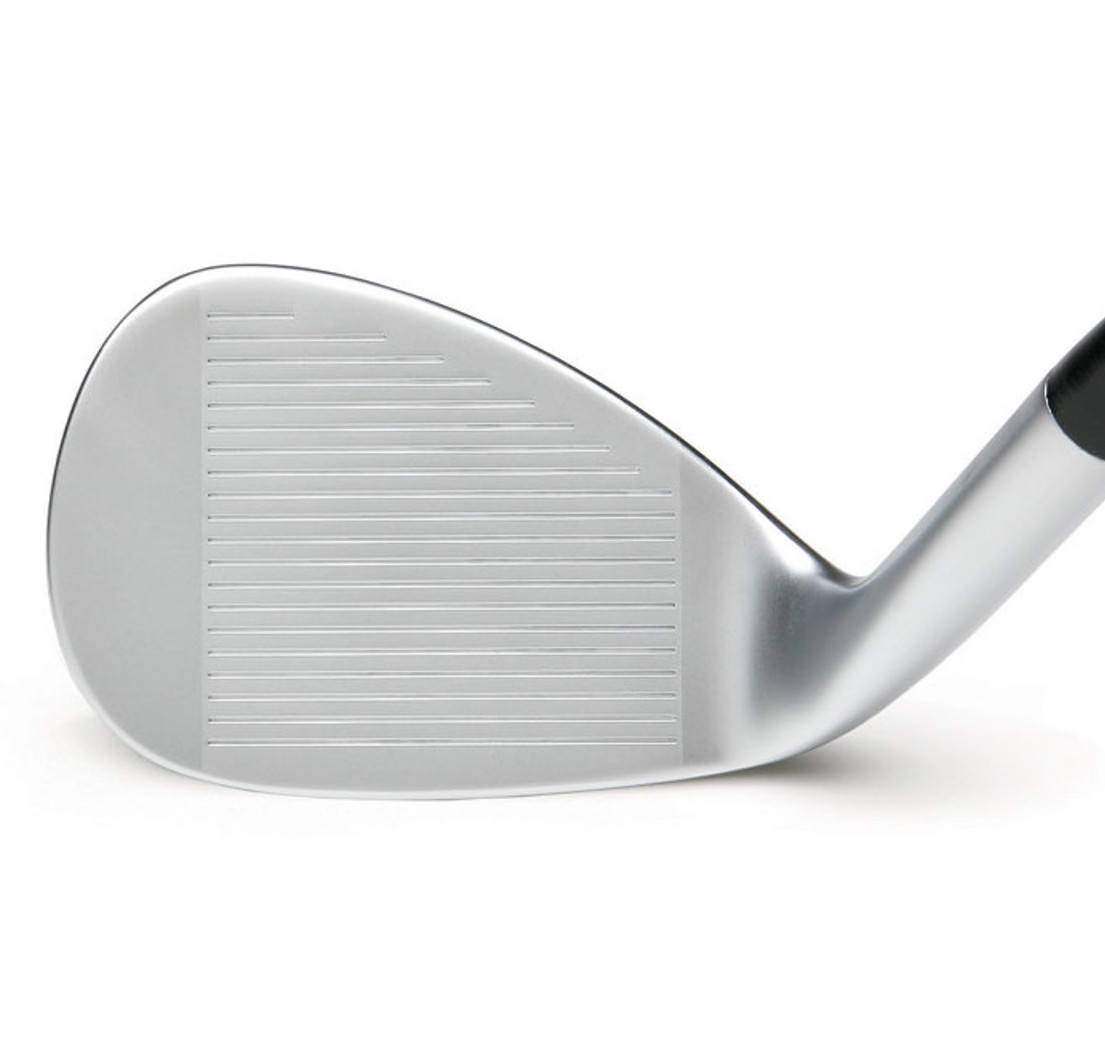
One side-effect of the relentless effort by major iron makers to win the “launch monitor wars” that pit one 6- or 7-iron against another is that the lofts throughout sets of irons have been continually strengthened to a point of what I consider ridiculousness. There are two major problems with this trend in specifications for sets of irons. The first is that to try to win the “launch monitor wars,” iron makers have to try to make their 6- and 7-irons go farther than the other guys’. That means making those mid-irons stronger in loft and using a bit of “trickery” by increasing the loft gapping between your higher-loft scoring clubs so that your “P-club” doesn’t get too strong, too (though modern “P-clubs” of 43-45 degrees of loft are really not “pitching wedges” at all).
Historically, iron lofts progressed through the set at four-degree loft intervals, and .5-inch length differentials. This wasn’t happenstance at all, it was the result of rigorous testing by professionals and average golfers. Those technical differences typically delivered consistent distance gapping from the pitching wedge down through the set.
A review of the specifications of almost every set of irons on the market today, however, will reveal that loft differentials are now five degrees between the short irons and as little as two degrees at the long end of the set. This is totally counter-intuitive to how you can improve your short iron and wedge precision. Why in the world would you want to increase the distance differences between your shorter irons, which is where you most need distance control precision? After all, a 6-iron shot that is 25 to 30 feet long or short is pretty darn good, but it sucks if you have a 9-iron or wedge in your hands.
Understand that the “holy grail” of distance in golf club design is the combination of high launch and low spin. Achieving this is relatively simple – put as much mass in the bottom of the golf clubhead as possible.
So, the second major problem caused by the “launch monitor wars” is how modern irons are designed. The early “solution” to longer-hitting mid-irons was extreme sole-weighting with thinner faces. The newer technologies we’re seeing in irons combine even faster faces with heavy tungsten inserts in the sole of the club.
But the problem with almost all irons on the market – especially in the “game improvement” category – is that this same design and technologies are applied throughout the “matched” set of irons and even into “wedges” that display that same design concept. And that’s where your prime scoring clubs are being compromised.
High launch and low spin are great in a driver or fairway wood, and maybe even desirable in your middle irons — but that is the exact opposite of what you need to achieve consistent distance precision in prime scoring range when you have a short iron or wedge in your hands.
Almost all accomplished players have learned to hit their short irons and wedges with a penetrating ball flight and lots of spin to stop the ball in its tracks once it hits the green. So why would you ever want to play short irons and wedges that have all their mass at the bottom, which is designed to deliver the exact opposite of what you should be seeking?
Now, let’s go back to the title of today’s post.
Either your 6- or 7-iron is 28 to 30 degrees of loft – but have you ever stopped to think that this loft is closer to that of your driver than to where your “wedge” lofts begin (around 45 degrees)? I feel certain that no golfer in the history of the world has ever proclaimed
“I really like my 7-iron. Can you make me a driver that looks just like it?”
In fact, from your 7-iron down to your driver, you likely have at least four, if not five, completely different clubhead designs in order to optimize performance at a given range of lofts. That iron design might evolve to a driving iron design a few degrees lower, then most likely to a hybrid design a few degrees lower than that, then to a fairway wood as lofts get below twenty degrees, and finally to a driver at 9 to 12 degrees.
So, if it takes four to five completely different clubhead designs to optimize performance at the long end of the set, how realistic is it that only one design throughout your set of irons can deliver the performance and precision you need at the short end?
I’ve always believed that every club in your bag has a specific purpose and expectation. Fairway woods, hybrids, and long irons are to get you close to or maybe even on the green from a long-distance approach. With middle irons (5 through 7 or 8), your goal is to get on the green within a reasonable distance, or certainly not to leave yourself a tough greenside save.
Your “money clubs” are those with lofts above 37 to 40 degrees, as this is where you have a chance to get close enough for the occasional one-putt, whether that is for a birdie, par, or bogey. And this is the end of your set where you likely have not spent the time to make sure it’s just right.
To accent just how important this part of your set really is, did you know (if you discount the fact that almost all so-called par-5 holes on the tour are really just long par 4s for those guys) the entire PGA Tour is over par outside 9-iron range?
Something to think about, for sure.
- LIKE59
- LEGIT18
- WOW4
- LOL2
- IDHT0
- FLOP4
- OB0
- SHANK3
-

 19th Hole2 weeks ago
19th Hole2 weeks agoTiger Woods delivered stinging message to major winner after denying him lift on private jet
-
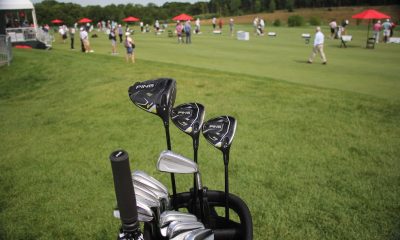
 Whats in the Bag2 weeks ago
Whats in the Bag2 weeks agoSeamus Power WITB 2023 (June)
-

 Whats in the Bag3 weeks ago
Whats in the Bag3 weeks agoOmar Morales WITB 2023 (June)
-

 Whats in the Bag3 weeks ago
Whats in the Bag3 weeks agoBlayne Barber WITB 2023 (June)
-

 Whats in the Bag3 weeks ago
Whats in the Bag3 weeks agoBen Carr WITB 2023 (June)
-
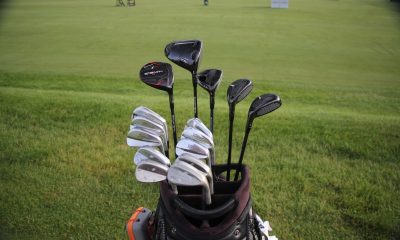
 Whats in the Bag2 weeks ago
Whats in the Bag2 weeks agoTom Hoge WITB 2023 (June)
-

 19th Hole3 weeks ago
19th Hole3 weeks agoJournalist alleges this is the ‘unforgivable’ act Phil Mickelson committed against Pat Perez and his wife
-
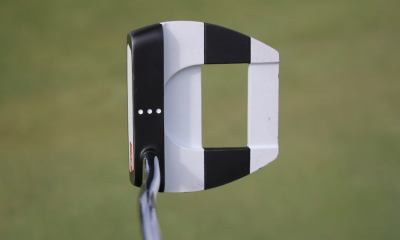
 News2 weeks ago
News2 weeks agoKeegan Bradley’s winning WITB: 2023 Travelers Championship







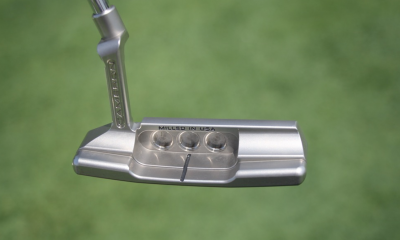

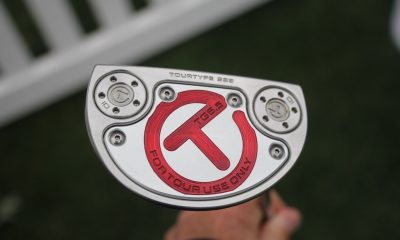



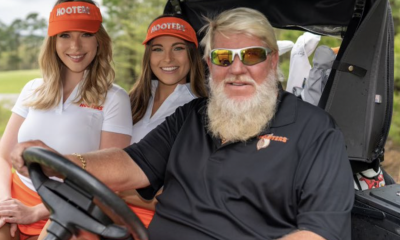











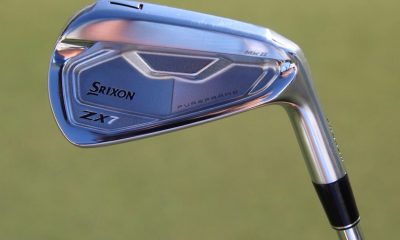

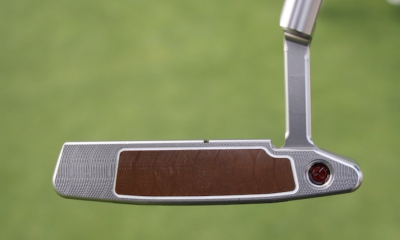

Thomas Horstmann
May 26, 2023 at 9:25 am
I think this has merit. Now how can we get a Park Golf course established in Poeira, IL We have the Peoria Park District with at least one or two regular golf courses that are no longer used. They are in beautiful park settings and could be easily established.
Pat
Apr 25, 2023 at 3:04 pm
Nope
jgpl001
Apr 24, 2023 at 5:44 am
The word “Craze” says it all, it is ABSOLUTE nonsense, end of
Schteve
Apr 22, 2023 at 8:08 am
This look awful, but is good for millenials.
Crashtestdummy
Apr 21, 2023 at 3:18 am
It looks fun and Might be entertaining every once in a while, but it definitely won’t motivate me to play and practice regularly. I’m addicted to golf. Lol.
John
Apr 20, 2023 at 2:26 pm
Looks like Yolf I’ve seen on a couple sites. Thought it may be some fun playing with my granddaughter.
U
Apr 20, 2023 at 1:18 pm
The PGA in the US will never allow this to take over as it will ruin their bottom line as their real courses and golf equipment shops. It will have to be done on its own as a separate sport and business away from the PGA if it is to succeed in the US.
Rick
Apr 20, 2023 at 11:35 am
I would like to see about 3/4 of the people on regular golf courses play this instead. Golf is hard, and they are just clogging up the courses for us!
Rascal
Apr 24, 2023 at 10:35 pm
This is what foot golf should have been imo